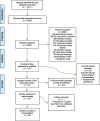Environmental and life-style risk factors for esophageal squamous cell carcinoma in Africa: a systematic review and meta-analysis
- PMID: 37710248
- PMCID: PMC10500769
- DOI: 10.1186/s12889-023-16629-0
Environmental and life-style risk factors for esophageal squamous cell carcinoma in Africa: a systematic review and meta-analysis
Abstract
Background: The African Esophageal Squamous Cell Carcinoma (ESCC) corridor, which spans from Ethiopia down to South Africa, is an esophageal cancer hotspot. Disproportionately high incidence and mortality rates of esophageal cancer have been reported from this region. The aim of this study was to systematically assess the evidence on environmental and life-style risk factors associated with ESCC in African populations.
Methods: We followed the Preferred Reporting Items for Systematic Reviews and Meta-Analyses (PRISMA) guidelines and carried out a comprehensive search of all African published studies up to March 2023 using PubMed, Embase, Scopus, and African Index Medicus databases.
Results: We identified 45 studies with measures of association [odds ratio (OR), relative risk (RR), and 95% confidence intervals (95%CI)], which reported on several environmental and lifestyle risk factors for ESCC in Africa. We performed a meta-analysis on 38 studies investigating tobacco, alcohol use, combined tobacco and alcohol use, polycyclic aromatic hydrocarbon exposure, hot food and beverages consumption (which served as a proxy for esophageal injury through exposure to high temperature), and poor oral health. We found significant associations between all the risk factors and ESCC development. Analysis of fruit and vegetable consumption showed a protective effect. Using population attributable fraction (PAF) analysis, we calculated the proportion of ESCC attributable to tobacco (18%), alcohol use (12%), combined tobacco and alcohol use (18%), polycyclic aromatic hydrocarbon exposure (12%), hot food and beverages intake (16%), poor oral health (37%), and fruit and vegetable consumption (-12%).
Conclusions: Tobacco smoking and alcohol consumption were the most studied risk factors overall. Areas where there is an emerging body of evidence include hot food and beverages and oral health. Concurrently, new avenues of research are also emerging in PAH exposure, and diet as risk factors. Our results point to a multifactorial etiology of ESCC in African populations with further evidence on prevention potential.
Keywords: African esophageal cancer corridor; Attributable risk; Esophageal cancer; Risk factors; Systematic review.
© 2023. BioMed Central Ltd., part of Springer Nature.
Conflict of interest statement
The authors declare no competing interests.
Figures








References
Publication types
MeSH terms
Grants and funding
LinkOut - more resources
Full Text Sources
Medical

